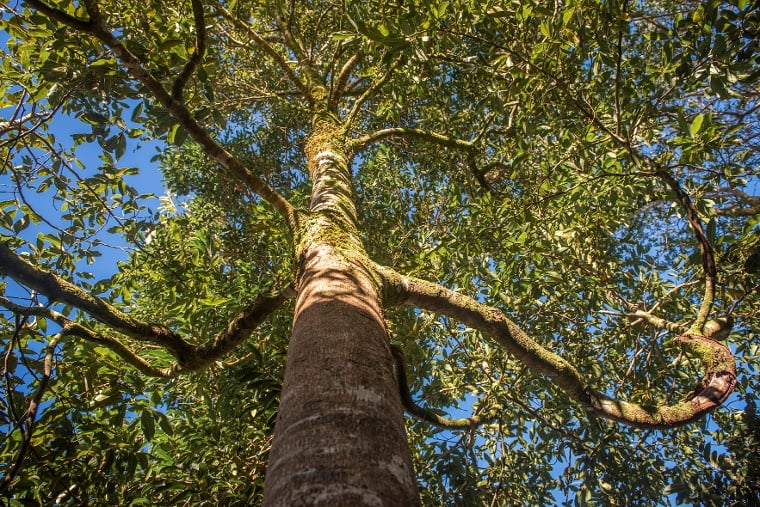Rise Up Along the Treetop Walkways in the Monteverde Reserves
.jpg)
Walking around in the cloud forest treetops offers a unique and exciting new perspective, allowing you to immerse yourself in the curious world that lives above the forest floor. It's an experience that will take your nature exploration to new heights (literally) and allow you to witness the canopy's extraordinary ecosystem up close.
From suspended bridges to elevated walkways, these pathways will offer you a thrilling journey through the trees, where you get to glimpse at the unique flora, fauna, and breathtaking views that only treetop exploration can unveil.
In this article, we’ll explore a little bit of what makes the Monteverde Cloud Forest so vibrant for elevated exploration, talk about why exactly it’s worthwhile to take a different perspective in the canopy and explore some options for doing so around Monteverde.
The Iconic Trees of Monteverde Cloud Forest
.jpg?width=800&height=480&name=Rise%20Up%20Along%20the%20Treetop%20Walkways%20in%20the%20Monteverde%20Reserves%20(5).jpg)
We've seen previously that Monteverde is well known for its lush cloud forest and diverse vegetation. But something that always strikes new visitors is the incredible diversity of trees here. Amongst them, get ready to see:
The Quercus Costaricensis (Roble Sabana)
A type of prominent oak tree with thick, dark green leaves, reaching heights up to 40 meters. They play a vital ecological role as they provide habitat and food for various wildlife species, contributing significantly to the biodiversity of the region. Beyond its ecological importance, the Roble Sabana holds cultural significance symbolizing resilience, adaptability, and the enduring connection between the Costa Rican people and their natural environment.
The Ficus Family (Particularly the Strangler Fig)
These fascinating trees start as epiphytes, which means they wrap themselves around a host tree and eventually grow so large they can envelop and "strangle" their hosts. We will talk more in-depth about this one further in the article.
The Cecropia Trees
These are fast-growing trees with large, distinctively lobed leaves. An interesting fact is that they team up with ants! Cecropia trees have special spots where ants live. In return for a home, these ants protect the tree from other insects that might feed on it. It's a little partnership (known as symbiosis) between the tree and the ants that keeps both species healthy and thriving.
The Guanacaste Tree (Enterolobium cyclocarpum)
This tree is known among many Costa Ricans for its expansive canopy and large, umbrella-shaped form. In the ecosystem, it has an important role, as lots of animals rely on it for food and shelter, keeping the wildlife diverse and cared for. Beyond that, the Guanacaste tree carries cultural weight. It’s one of Costa Rica’s national symbols and represents strength and endurance because of its robust nature and long life, and is fiercely protected by environmental regulations.
Climbing Monteverde’s Hollow Ficus Trees
.jpg?width=800&height=480&name=Rise%20Up%20Along%20the%20Treetop%20Walkways%20in%20the%20Monteverde%20Reserves%20(9).jpg)
The strangler fig is a species of tree worth exploring a little further, as it has one of the most fascinating and transformative life cycles found in the Monteverde Cloud Forest.
The strangler fig starts as a small seed that lands high up in the canopy of another tree, though it’s not picky about which tree it lands on. Then, as the stranger fig grows, its roots start reaching down, grabbing onto the host tree and eventually reaching the ground.
Here's where it gets interesting: these roots keep growing and start surrounding the other tree. Over time, these roots get thicker and stronger, forming a lattice around the trunk. As the fig tree keeps growing, it gets its nutrients from the ground, and those strong roots can end up completely surrounding and, well, "strangling" the host tree.
More often than not, the host tree dies because it can't get enough nutrients, and what’s left behind is the fig tree with a hollow space inside where the host has decomposed and rotted away.
These trees are breathtaking to see in person, especially when you notice the complex patterns the roots create as they wrap around the host. It's a reminder of how resilient and adaptive nature can be, and how even trees can engage in epic, life-and-death struggles.
The Advantages of Reaching for the Sky
.jpg?width=800&height=480&name=Rise%20Up%20Along%20the%20Treetop%20Walkways%20in%20the%20Monteverde%20Reserves%20(7).jpg)
Walking on treetop walkways provides an unparalleled experience that goes beyond the conventional ways of exploring forests. Picture yourself suspended in the canopy, walking along a pathway that seems to float inside the lush greenery, far removed from the forest floor.
As you step onto these elevated walkways, there's an immediate sense of entering a hidden and unknown world, and that can be both serene and thrilling. The canopy stretches in all directions, enveloping you in a mosaic of sensations: the rustle of leaves, the distant calls of birds or monkeys, and the occasional creaking of branches in the wind. The sunlight peeks through the leaves of enormous trees, creating a mesmerizing play of light and shadow.
Walking on these treetop walkways provides an opportunity for contemplation and reflection. It's a chance to disconnect from the distractions of daily life and immerse yourself fully in the tranquility and majesty of nature.
An Entirely Different World
In addition, there are plants and animals that you’ll find above the canopy that simply don’t put foot on the ground.
Scientists estimate that 60-90% of life in the rainforest is found up in the trees, making this the richest habitat on the planet for plant and animal life. Many well-known animals including monkeys, frogs, lizards, birds, snakes, and sloths are almost exclusively found in the treetops.
This is easily explained by the conditions of the canopy, which are very different from the conditions of the forest floor. The canopy microclimate has direct influences on nearly all biophysical processes in plants including respiration, and growth.
During the day, the canopy is drier and hotter than other parts of the forest, as the trees are keeping the heat and sending it down the underlayer. Meanwhile, the plants and animals that live up there are specially adapted for life in the trees.
For example, because the amount of leaves in the canopy can make it difficult to see more than a few feet, many canopy animals rely on loud calls or lyrical songs for communication. Gaps between trees mean that some canopy animals fly, glide, or jump to move about in the treetops. On the other hand, at night, studies showed that the trees are able to retain the heat from the day and reuse it to keep the same temperature range.
At any time, one of the many canopy tree species is likely to be in blossom or in fruit at any time of the year. Crowds of birds, monkeys, and other animals that eat nectar, fruit, seeds, or leaves follow this moveable feast, never having to return to the forest floor. Take a moment when you’re up in the treetops — you might catch sight of a bird hanging by one foot as it uses its other to hold a piece of fruit it is chewing, or you might hear the calls all around you of some toucans and howler monkeys as they prowl around in the branches.
Where and How to Walk Along the Treetops in Monteverde
.jpg?width=800&height=480&name=Rise%20Up%20Along%20the%20Treetop%20Walkways%20in%20the%20Monteverde%20Reserves%20(6).jpg)
You can walk or venture along the treetops in a few different ways, so there’s something for everyone:
Hanging Bridges and Elevated Walkways
These sturdy bridges suspended in the trees let you stroll through the forest canopy, giving a cool, elevated view. They're stable and safe, so you can take your time and enjoy the scenery. It's like being on a high-level nature walk, where you can spot birds and monkeys moving around right on your level.
Aerial Trams or Gondolas
Picture a slow, peaceful ride above the trees. Aerial trams or gondolas glide smoothly along a cableway, giving you a calm and scenic view of the canopy. You can sit back, relax, and enjoy the ride while admiring the cloud forest from above. Some might have stops where you can step out and take pictures.
Canopy Tours or Ziplines
If you're up for a thrill, canopy tours or ziplines are the way to go! You're strapped in your safety harness and glide from platform to platform, sometimes at speeds of over 40km/h! It's an exciting rush, zooming above the trees and feeling like you're flying. Not everyone's cup of tea, but if you like adventure, this is a must-try!
Each way of exploring the treetops offers its own experience, from a relaxed stroll to an adrenaline-pumping adventure. No matter which you choose, it's all about soaking up the beauty of the forest from a whole new perspective.
What to Expect and What to Bring
.jpg?width=800&height=480&name=Rise%20Up%20Along%20the%20Treetop%20Walkways%20in%20the%20Monteverde%20Reserves%20(10).jpg)
Some insect repellent, closed/hiking shoes, comfortable clothing, and a raincoat will come in handy for your tree walk exploration. If you're into photography, don't forget to bring your gear with you for unforgettable memories. Last tip, make sure you always use a reusable water bottle during your stay, and fill it up before leaving — even in the clouds, it’s possible to get thirsty.
So if you feel ready to reach for the sky, we will be here, in the top trees waiting for you to join us on the adventure! To learn more, you can reach out to us at info@ocoteahotel.com.




.jpg)
